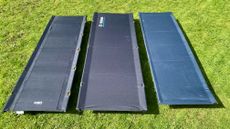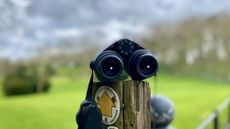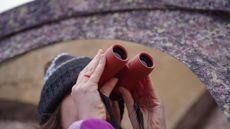The DJI Mini 3 Pro reviewed here is the latest drone from the biggest name in remote-controlled flying right now.
DJI has drones to suit every type of drone pilot or content creator, from entry-level models like the DJI Mini 2 and DJI Mini SE to the DJI Mavic 3 for serious aerial photographers and filmmakers who need to travel light and the Inspire 2 for high-end shoots.
Over the years, DJI has made its drones increasingly easy to fly, with automated flight modes that enable inexperienced flyers to create exciting videos without having to guide the drone through any complex manoeuvres. These have opened up aerial photography and videography to a whole new audience.
The newest addition to the lineup – the DJI Mini 3 Pro – is aimed at enthusiast photographers and videographers, as well as those people who want to experience the fun of shooting from more interesting and creative angles without getting bogged down by drone regulations or flying qualifications.
I tried one out to see if it's good enough to fly with the rest of the market's best drones (or best drones for beginners). Here's my DJI Mini 3 Pro review.
[We reviewed the successor of the Mini 3 Pro here: DJI Mini 4 Pro review. We also compared the two, and you can read all about here: DJI Mini 4 Pro vs DJI Mini 3 Pro.]
DJI Mini 3 Pro review: price and release date
The DJI Mini 3 Pro launched in May 2022. It's possible to buy the drone three configurations:
- DJI Mini 3 Pro (No RC): £639 GBP / $669 USD / $989 AUD – no remote controller
- DJI Mini 3 Pro: £639 GBP / $759 USD / $ 1,119 AUD – with smartphone remote controller
- DJI Mini 3 Pro (DJI RC): £859 GBP / $909 USD / $1,299 AUD – with DJI's new remote controller, which has its own screen
In addition, there's the DJI Mini 3 Pro Fly More Kit, which includes 2 Intelligent Flight Batteries, a two-way charging hub, two sets of propellers, and a shoulder bag for £159 GBP / $189 USD / $259 AUD.
In some areas it's also possible to buy the DJI Mini 3 Pro Fly More Kit Plus, which includes everything in the DJI Mini 3 Pro Fly More Kit but the batteries are the Intelligent Flight Battery Plus version that give up to 47 minutes flight. This kit retails for $249 USD / $359 and is not available in the EU or UK.
I tested the DJI Mini 3 Pro and the DJI Mini 3 Pro (DJI RC) kits.
DJI Mini 3 Pro review: features and what's new
DJI Mini 3 Pro specs
Weight: "less than 249g"
Sensor: 1/1.3-inch
Aperture: f/1.7
Battery life: 34-min
Transmitter range: 12km 1080p/30fps
Video: 4K/60fps videos and 4K/30fps HDR videos
Photo: 48MP JPEG/DNG (RAW)
As you might guess, the DJI Mini 3 Pro reviewed here is the third iteration of DJI's Mini series but while the DJI Mini 2 dropped the 'Mavic' label of its predecessor, the Mini 3 Pro has gained 'Pro'. That addition to the name might seem strange for a drone that's primarily aimed at enthusiasts, but it's likely in recognition of the impressive sensor size increase, jumping from a 1/2.3-inch type sensor to a 1/1.3-inch type to boost image quality.
What's even more impressive is that despite moving from a 1/2.3-inch type sensor to a slightly larger 1/1.3-inch type, DJI has managed to keep the Mini 3 Pro's weight down below the magic 250g mark. In fact, it's listed as under 249g. That's significant, because in many territories it means it avoids many of the requirements of the drone regulations and you can pretty much fly it wherever you like.
In the UK, you have to get a Flyer ID and Operator ID from the CAA to fly but after that, provided you avoid the flight restriction zones around places like airports, prisons and military bases, you can fly it with relative freedom in residential, recreational and industrial areas. You can find out all about the registration process in our guide to UK drone regulations, while US readers should check our guide to US drone rules and regulations.
Like the Mini 2, the DJI Mini 3 Pro has a 12MP sensor. However, the 3 uses a quad-Bayer designed, which basically means each pixel is split in four that can report separately or together. As a result, the Mini 3 Pro can shoot 48Mp images in raw or JPEG format as well as 12MP images. And on the video front, the Mini 3 Pro can shoot 4K (3840×2160), 2.7K (2720×1530) or Full-HD (1920x1080) video at up to 60p or 1920x1080 video in Slow Motion mode at up to 120p.
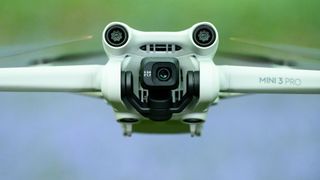
DJI has loaded the Mini 3 Pro with its excellent Mastershots, FocusTrack and QuickShots options that create great footage while the drone flies itself, and added forward, rearward and downward-facing sensors to inform the new object avoidance system. Sadly, there is no upward sensor, so you need to take care if you're taking off under trees.
In addition, with a tap on the controller screen, the camera can change orientation from landscape to portrait and back. That's perfect for TicTok and Instagram etc.
Small, light drones usually mean short flights because their batteries are quickly depleted, but the Intelligent Flight Battery provides has enough juice for flights of up to 34 minutes. These times can often seem optimistic, but I found them achievable depending upon the conditions and the type of flying I was doing.

DJI Mini 3 Pro review: setup and use
When it's folded, the DJI Mini 3 Pro measures just 145×90×62mm, which means it can sit on the palm of your hand. With the legs unfolded, it's 251×362×70mm including the propellers, which means you can fit it through quite small gaps between branches and the like, but you'll have to turn off the obstacle avoidance system first as it's effective at stopping the drone getting close to objects in front of it.
After inserting and charging the battery, the next step in using the Mini 3 Pro is to turn it on, connect it with the controller and check for any firmware updates. This only takes a few minutes but it's a good idea to do it at home where you have a decent Wi-Fi connection as sometimes you can't fly until the update has been made.
DJI Mini 3 Pro review: DJI controller
DJI sells the Mini 3 Pro without a controller for anyone who is upgrading and already has a unit. However, it's also available with the DJI RC-N1 Remote Controller which has a clamp and connection for a smartphone, or the DJI RC which has a nice bright screen so you don't need to connect your phone. I used both types of controller and although the DJI RC-N1 Remote Controller is easy enough to set-up, it's nice to not put your phone out of action or to have the wrestle with the clamp, so I'd lean towards the DJI RC Remote Controller as my preference. It also benefits from an extra couple of customisable buttons and an additional dial.
Whichever controller you use, it runs DJI's Fly app to control the drone. This is very straightforward to use and lets you swap around the settings quickly.

DJI Mini 3 Pro review: performance
A 1/1.3-inch type sensor is bigger than the sensors in the average compact camera and its impact is immediately apparent in the results from the Mini 3 Pro, they are a clear step up from those from the Mini 2. Okay, they're not quite as amazing as what you get from the DJI Mavic 3, but that's in a completely different ballpark price-wise and has an even bigger sensor. That said, I found the Mini 3 Pro doesn't suffer quite so much from flare.
The level of detail in 12MP images is good, but switch to 48Mp and it's very impressive indeed. If you zoom into the 12MP images so they match the size of the 48MP images at 100%, the 48MP shots look way better and have much more detail.
Similarly, the 4K video footage from the Mini 3 Pro is excellent and movement looks smooth while colours are natural. However, I'd advise going for a manual white balance setting as the auto setting is prone to altering if the colours in your scene change.
While the gimbal does a good job of keeping the camera steady, it only takes a relatively light breeze to buffet the Mini 3 Pro. In some cases it will go unnoticed, but occasionally you'll see a little movement.
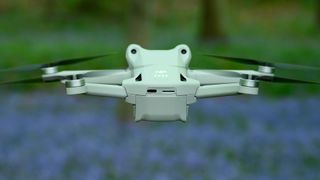
DJI Mini 3 Pro review: alternatives to consider
If you want to get serious about aerial photography and videography, take a look at the DJI Mavic 3. It's not as small or light as the Mini 3 Pro, so you need to consider the drone regulations, but it's still reasonably portable and it delivers pro-quality results. Naturally, it also commands a higher price tag (GBP £1,879 / USD $2,199 / AUD $3,099). If that's too much, take a peek at the DJI Air 2S, which is very capable at £899 GBP/ $999 USD / $1,699 AUD.
Alternatively, if you're just looking for something that you can have some fun with, there's the DJI Mini SE which, like the Mini 3 Pro, weighs less than 249g so you have stress-free flying. Its video resolution tops out at 2.7K but it retails for just £269 GBP / $299 USD / $459 AUD.
DJI Mini 3 Pro review: verdict
So now to the really important bit of my DJI Mini 3 Pro drone review: should you buy one? With its 1/1.3-inch type sensor, obstacle avoidance and superior image quality, the DJI Mini 3 Pro goes beyond an entry-level drone. In fact, it even surpasses the DJI Mavic Air 2 which has a 1/2-inch type sensor and weighs 570g, giving you more to think about before flying.
Consequently, the DJI Mini 3 Pro makes a great choice of drone for its target market of enthusiast photographers and videographers, but it also has enough to offer experienced drone pilots looking for something they can take everywhere and fly at a moment's notice.







